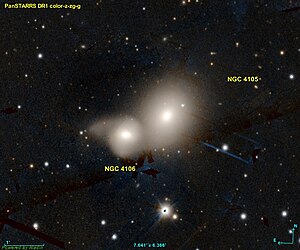NGC 4106
| Galaxy NGC 4106 |
|
|---|---|

|
|
| AladinLite | |
| Constellation | Water snake |
|
Position equinox : J2000.0 , epoch : J2000.0 |
|
| Right ascension | 12 h 06 m 44.800 s |
| declination | -29 ° 46 ′ 05.90 ″ |
| Appearance | |
| Morphological type | SB (s) 0+ |
| Brightness (visual) | 11.4 mag |
| Brightness (B-band) | 12.4 mag |
| Angular expansion | 1.6 '× 1.3' |
| Position angle | 77 ° |
| Surface brightness | 12.0 mag / arcmin² |
| Physical data | |
| Affiliation | IC 764 group LGG 271 |
| Redshift | 0.007172 ± 0.000057 |
| Radial velocity | (2150 ± 17) km / s |
|
Stroke distance v rad / H 0 |
(88 ± 6) x 10 6 ly (27.0 ± 1.9) Mpc |
| history | |
| discovery | William Herschel |
| Discovery date | March 7, 1791 |
| Catalog names | |
| NGC 4106 • PGC 38417 • ESO 440-056 • MCG -05-29-014 • 2MASX i J1206447-294605 • SGC 120410-2929.4 • GC 2721 • H II 866 • h 3379 • | |
NGC 4106 is a lenticular galaxy of the Hubble type SB0 / a in the constellation Hydra south of the ecliptic . It is estimated to be 88 million light years from the Milky Way and about 40,000 light years in diameter. Presumably it forms a gravitationally bound galaxy pair together with NGC 4105 . The galaxy is considered a member of the IC 764 group ( LGG 271 ).
The galaxies IC 760 , IC 2996 , IC 3005 , IC 3010 are located in the same area of the sky .
The object was discovered by Wilhelm Herschel on March 7, 1791 .
